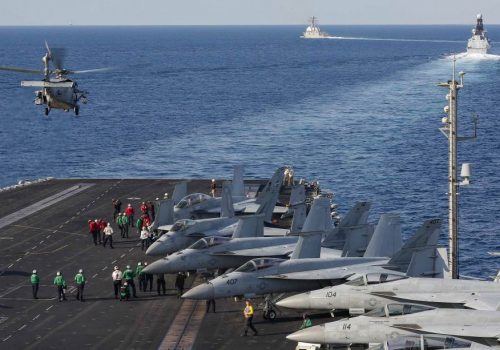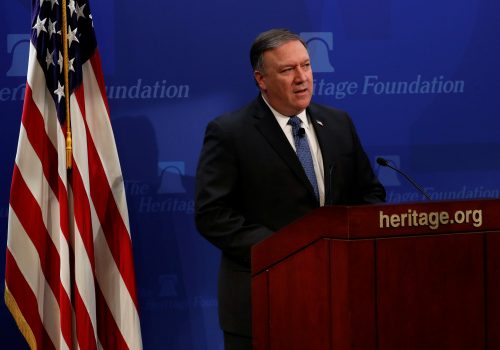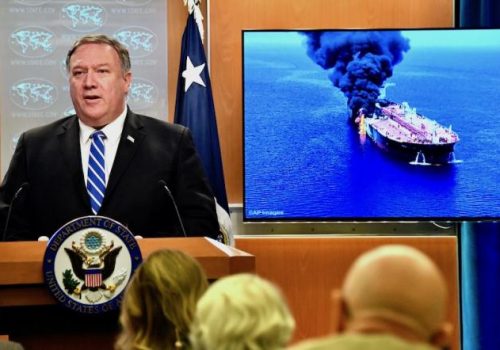How to fix the “maximum pressure” campaign on Iran
Despite predictions to the contrary, since its withdrawal from the 2015 nuclear deal, the United States has succeeded in erecting a robust and effective sanctions regime against Tehran. By means of an elaborate system of secondary sanctions, the Trump administration has caused the Iranian economy unprecedented damage, which the coronavirus pandemic has only exacerbated.
However, assuming that pressure on Iran is not an end in itself, but rather aimed at pursuing political-diplomatic objectives, the Trump administration has so far failed in translating the significant leverage it has created vis-à-vis Iran into strategic achievements. Worse yet, it seems the pressure has yielded the opposite results.
Instead of restraining its nuclear program, Tehran has steadily expanded it since May 2019. At this point, Iran would only need a few months to produce enough fissile material for a nuclear weapon in a worst-case scenario. Rather than curbing its malign activities in the region, Iran’s behavior has become increasingly aggressive and risk-prone, as demonstrated in the downing of a US drone in June 2019 and the attack on Saudi oil facilities in September 2019. Iran accelerated its efforts to support terror organizations—the Lebanese militant group Hezbollah chief among them—and to entrench itself militarily in the region. Iran’s expanding military presence in Syria and in Iraq and the Iranian-led precision-guided missile project of Hezbollah have forced Israel to step-up its military operations to push back against Iran in the framework of what is known as Israel’s “Campaign Between Wars”.
What is wrong with the “maximum pressure” campaign, which doesn’t bring the desired results even as pressure against Iran is only mounting? Beyond the obvious difficulty of persuading Iran to return to the negotiating table after the US withdrawal from the Joint Comprehensive Plan of Action (JCPOA) in May 2018, the Trump administration’s strategy suffers from internal tensions and inherent contradictions that have undermined its effectiveness from the beginning.
The Trump administration rightfully contended that the nuclear deal stymied its ability to use punitive sanctions to block Iran’s malign activities in the region and its ballistic missile program. The JCPOA had removed debilitating sanctions on the energy and financial sectors that could not be reinstated without violating the agreement. Thus, the nuclear deal offered Iran some form of impunity to carry out its destabilizing regional policy—as it did—exempted of any cost.
But the Trump administration’s remedy for these drawbacks has been counterproductive. Attempting to address this problem after withdrawing from the JCPOA, the Trump administration presented Iran with a list of twelve far-reaching demands as conditions for sanctions relief. The list demands that Iran give up enrichment of uranium, entirely, as well as development of nuclear-capable missile systems; cease its backing of terrorist groups such as Hezbollah and Palestinian Islamic Jihad; respect the sovereignty of Iraq; withdraw forces under its command from Syria; cease threatening the state of Israel and other regional countries; and more.
With its sweeping demands, the administration created a new problem of exaggerated reliance and the over-burdening of the instrument of sanctions, which has undermined its ability to motivate the Iranian regime to comply with the demands.
The administration’s decision to couple together the nuclear issue and Iran’s malign activity in the region is also liable to boomerang for the administration, should Iran decide to return to the negotiating table at any point. Beyond the bargaining over the intricate and barely-measurable regional issues that are likely to drag on and on, Iran will be able to leverage alleged concessions in the region in exchange for demands in the nuclear realm. Prolonged negotiations are even more problematic while Iran is simultaneously expanding its nuclear program, offering it increased bargaining leverage. For these reasons, the US and Israel vehemently opposed Iran’s suggestion to combine both issues and reach a “grand bargain” in past negotiations, considering it a foot-dragging ploy.
Beyond the widespread scope of issues, the administration’s objectives appear to be unrealistic: on the one hand, demanding Tehran to acquiesce to “zero enrichment” and, on the other hand, demanding it to behave as a “normal state” in the Middle East, “like Norway.”
Despite repeated clarifications by the Trump administration that it is willing to negotiate without any “preconditions” and that it will not pursue a policy of regime change, the maximalist demands it has set forth are perceived in Tehran to be unacceptable terms that conceal the administration’s true objective—perpetuating sanctions and toppling the regime. Under these circumstances and while the messages from Washington are inconsistent and Israeli leaders are calling to “totter” the regime even further, the authorities in Tehran increasingly believe that there is no point in returning to the negotiating table.
Another main weakness of the “maximum pressure” campaign, which was also pointed out recently by the head of US Central Command (CENTCOM), General Kenneth McKenzie, is the lack of a credible military threat. Despite the killing of the Islamic Revolutionary Guards Corp’s Quds Force commander, Qasem Soleimani, the reluctance of the administration—and of President Donald Trump, personally—to use military force against Iran, as long as it doesn’t harm Americans, is clearly evident. The president loathes the unending wars of the Middle East and seeks to leave the region. The exclusive reliance on the leveraging of sanctions without a credible military threat harms the effectiveness of the overall strategy and its likelihood to deter Iran from expanding its nuclear program and its efforts to entrench itself militarily across the region.
In sum, the Trump administration’s strategy sets forth a correlation between maximum pressure and maximum achievements. However, this formula is not viable—not even in the face of unprecedented Iranian suffering due to sanctions and the coronavirus. The Iranian challenge is too big and too complex to be solved in one bold move—the “grand bargain”—that would mean capitulation and a threat to the very existence of the Islamic Republic from Supreme Leader Ayatollah Ali Khamenei’s perspective.
The current US policy appears to be based on an all or nothing approach that will most likely lead to a dead-end. Over time, a deadlock could narrow US and Israeli diplomatic freedom of maneuverability and gradually take them back to a situation where the military option—not optimal and bearing a heavy price— becomes the only alternative left to blocking Iran’s path to nuclear weapons.
On the other hand, a more nuanced strategy based on priorities—a combination of carrots and sticks, blocking measures and incentives, and partial or interim arrangements—could make the most of the significant leverage that the Trump administration has created for Iran.
The prospects of the maximum pressure strategy will improve should the Trump administration adopt the following measures:
- Parallel to maintaining current pressure and even intensifying it, provide guarantees to Tehran that the US is not seeking to topple it.
- Focus and limit sanctions—and their conditions for relief—only to the nuclear file. This would mean concentrating on amending the dangerous shortcomings of the JCPOA, primarily the “sunset” clauses, research and development of advanced centrifuges and the unsatisfactory supervision and verification procedures of the International Atomic Energy Agency, regarding weaponization.
- Bolster the sanctions regime with a credible, significant, and robust military threat related to the nuclear program. The credibility of the military threat will be shaped by American willingness to challenge Iran’s malign activities on the ground, much in the way Israel has struggled with Iran’s military entrenchment in Syria. This should include, for example, blocking Iranian arms transfers across the region and using coercive measures, if need be.
- Pursue creative diplomatic solutions. For instance, bridging the differences regarding the sunset clauses is expected to be difficult considering the US withdrawal from the original nuclear agreement. Nevertheless, one can think of ideas to buy time, such as an interim agreement for a few years, which would be automatically renewable at the consent of both parties, thus, allowing any party to withdraw with a one-year notice.
These modifications to the “maximum pressure” campaign will set the scene immediately for more effective Iran policy after the 2020 US presidential election. A nuanced policy could serve both President Trump, if reelected, and presumptive Democratic presidential nominee Joe Biden—whose team has already been crafting an Iran strategy—should he win the elections.
Colonel (res.) Udi Evental is a senior research fellow at the Institute for Policy and Strategy (IPS) at IDC Herzliya. Follow him on Twitter: @uevental.
Image: Special Representative for Iran Brian Hook addresses reporters at the U.S. Department of State in Washington, D.C., on December 5, 2019. [State Department photo by Freddie Everett/ Public Domain]


